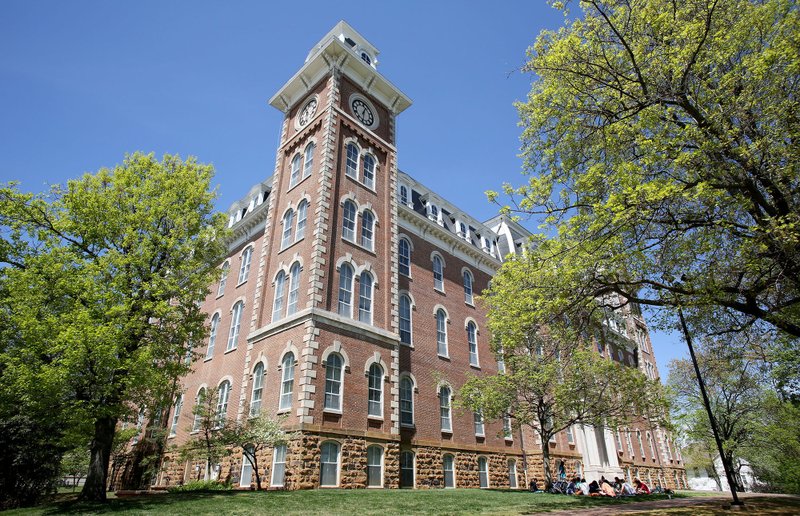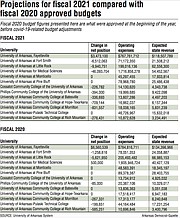University of Arkansas System trustees Thursday approved reduced budgets at most campuses for next year, the result of cautious planning for lower state revenue and shrinking enrollment.
After years of increasing tuition and fees to cover rising operating costs, system schools are keeping those rates the same while instituting or continuing hiring freezes and reducing spending on supplies and services. Most have said they aren't currently planning layoffs.
Trustees approved the budgets on a voice vote without opposition. Collectively, they trim tens of millions of dollars from the schools' budgets.
Colleges nationwide are grappling with financial losses and dismal enrollment and financial projections for the fall. Many public institutions have already struggled with declining state revenue since the Great Recession.
In Arkansas, state revenue had largely been stagnant, rather than shrinking, until the coronavirus pandemic. Several schools have created committees to look at the pandemic's impact and explore what other budget reduction options they may have in the near future, including layoffs.
University of Arkansas System budgets, which contracted at most schools and expanded slightly at others, were submitted by the chancellors of each campus, but not without direction from system administrators.
Trustees directed the chancellors to keep tuition and fees flat for the fall while reserving the right to increase them, if needed, for the spring. System President Donald Bobbitt asked the chancellors to create their budgets assuming that state revenue would cover only certain general appropriation categories, while still fulfilling most of what has been promised to campuses.
Gina Terry, system vice president of finance and administration, said planning for next year's budgets was the most challenging effort of her career.
"Just the uncertainties that are out there right now with housing and enrollment and athletics," she said. "It really challenges each campus to try to figure out how to manage and try not to have layoffs, if they can help it."
The University of Arkansas at Monticello reported plans to lay off at least one person. Details on the number of people laid off and what their jobs were have been unavailable this week. The university budgeted expenditures of $3.3 million less next year compared with what was approved for this year.
The approved spending decreases at the system's schools, compared with last year's approved expenditures, represent as much as 11.7% less.
That percentage is the amount stripped from the budget for the University of Arkansas at Pine Bluff, the state's only public historically black college or university.
At the flagship institution, the University of Arkansas, Fayetteville, cuts amount to just more than 2% of last year's approved expenditures.
Out of the system's five traditional four-year institutions, its medical school and its seven community colleges, all but four expect a deficit next year, to be covered by reserves. UALR expects to spend $9.9 million in reserves to cover its shortfall, and the University of Arkansas at Fort Smith intends to spend $4 million of the $9.7 million in its education and general reserve fund to cover the portion of its shortfall that is in its education and general budget.
The traditional four-year universities and seven community colleges collectively axed $41.5 million from their proposed expenditures, compared with what was approved last year. That's out of $1.3 billion in planned expenses, or a 3.2% spending decrease.
Universities were hit the hardest, while the largest budget reduction at a community college was 3.8% at the University of Arkansas Community College at Hope-Texarkana.
There, administrators reduced compensation by planning to use adjunct faculty and part-time help, a common tactic when colleges cut expenses. The college is also deferring about $250,000 in critical maintenance.
The college expects to lose 20% of its typical local sales tax revenue and 20% of its typical funding from Workforce 2000, part of its state appropriation.
Trustee Cliff Gibson thanked the schools for looking as deeply inward as they did to find cuts.
"What anecdotally I've learned is that everybody was pulled in, right down to the guy that mows the yard, trying to figure out, 'What can we do?'" he said.
UA System President Donald Bobbitt said years of conservative budgeting and prioritizing healthy "rainy day" reserve funds at each campus has helped keep the impacts minimal.
"And it's rainy," he said.
This story has been updated. A previous version incorrectly stated how much the University of Arkansas at Fort Smith had in reserves.
A Section on 05/22/2020


